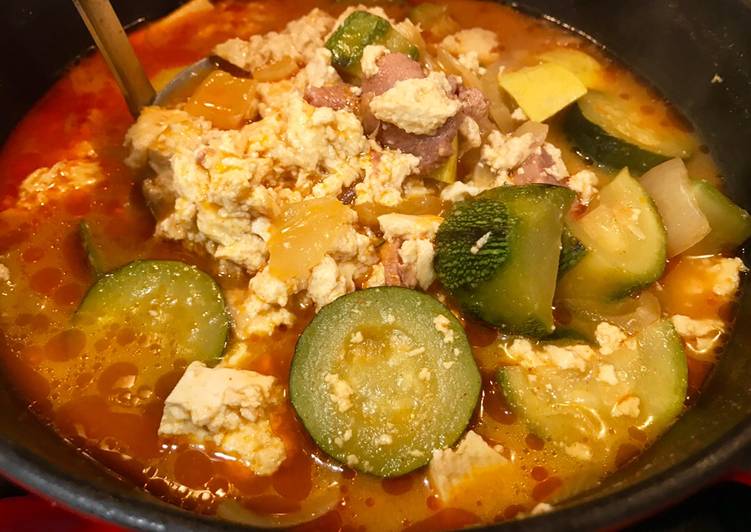Spicy Hobak Jjigae (Korean Squash Stew) with Pork & Tofu. Gochujang Jjigae (Gochujang Stew with Zucchini). Gochujang adds lots of spicy, robust flavors to this simple stew made with summer zucchini and potatoes. Other times, we also love pork for a rich, meaty stew.
 Shitake broth makes it extra flavorful. My light and meatless take on a classic Korean stew that traditionally uses beef or pork. The broth is made with dried anchovy stock so it's not. You can have Spicy Hobak Jjigae (Korean Squash Stew) with Pork & Tofu using 9 ingredients and 5 steps. Here is how you cook that.
Shitake broth makes it extra flavorful. My light and meatless take on a classic Korean stew that traditionally uses beef or pork. The broth is made with dried anchovy stock so it's not. You can have Spicy Hobak Jjigae (Korean Squash Stew) with Pork & Tofu using 9 ingredients and 5 steps. Here is how you cook that.
Ingredients of Spicy Hobak Jjigae (Korean Squash Stew) with Pork & Tofu
- Prepare 1/2 of onion, diced.
- Prepare 1-2 of jalapeños, cut into 1/8" thick slices.
- It's 2-4 of garlic cloves peeled and smashed (or chopped).
- You need 1/2 pound of pork shoulder, thinly sliced.
- You need 1/4 cup of dwenjang (Korean soybean paste) OR miso (which is the Japanese version).
- Prepare 1/4 cup of gochujang (Korean chili paste).
- Prepare 4 cups of water.
- Prepare 4 cups of calabacita squash or zucchini, cut into 1/2" thick slices (about 2 to 3 medium squashes).
- You need 1 (14 oz.) of package tofu (can be any firmness).
This spicy kimchi jjigae (kimchichigae) or kimchi stew is a favorite winter meal in Korea. It is best served with white rice to help balance the heat. Kimchi stew (kimchi jjigae or kimchichigae) combines kimchi with other ingredients such as beef, onions, garlic, and tofu. It is meant to be eaten slowly, and.
Spicy Hobak Jjigae (Korean Squash Stew) with Pork & Tofu step by step
- Put all ingredients except squash and tofu in a pot, cover, turn the heat to medium high, and cook for 15 minutes..
- Give the jjigae a few good stirs. You'll see the jjigae change color as the dwenjang and gochujang dissolve into the broth. Let the jjigae continue cooking uncovered for 2 to 3 minutes until it comes to a boil..
- Add squash, give it a few good stirs, and cook another 15 minutes covered..
- Crumble tofu into the jjigae. (This is not typical - usually it's cut into cubes or slices - but I like it this way because the tofu picks up more flavor from the broth.) Cover and cook another 10 minutes. Don't worry that the broth is constantly boiling rather than simmering. Jjigae gets its well developed pungency from this constant application of higher heat and the resulting compounding, melding, and reduction of flavors..
- At this point, give everything another good stir and see if you need to adjust the seasoning. If it tastes fine, you're done. If a little too salty, add a touch of water. If you want more saltiness, you can add a little more dwenjang and/or gochujang, remembering that the gochujang is much hotter (as in spicy) than the dwenjang. If you do adjust the seasoning, let it boil another 4 or 5 minutes to let the new level of seasoning meld. That's it. Enjoy!.
Serve with rice and you will have the spicy Korean comfort on either cold and hot day! Here is one recipe I'd like to introduce to you. This spicy pork and zucchini stew (호박 고추장 찌개, hobak gochujang jjigae) originated from the Jeonla province, the southwestern part of Korea. This all happened since the Korean government (more specifically the National Institute of the Korean Language, 국립 국어원) has been Anyway, my spicy chicken stew recipe is really delicious. Even my little girl loved it despite the spiciness.